If the head rings a bell, that’s because this ASUS ZenWiFi BD5 Outdoor is, well, the “outdoor” version of the standard ZenWiFi BD5 I reviewed earlier this week.
Truth be told, I actually tested the two together initially, but during the process, I decided that this Outdoor unit deserved more attention. That said, make sure you read the ZenWiFi BD5’s review first, as this post complements that. Other than the ruggedness and PoE notions of the Outdoor, the two are practically the same.
Here’s the bottom line: The ASUS ZenWiFi BD5 Outdoor might not be applicable to everyone, but for those with a sprawling backyard or need to bring Wi-Fi to that Wi-Fi camera at the far end of a barn, it’s one of the best solution—comparatively a great deal in fact—whether or not you already have an ASUS Wi-Fi 7 system. It sure helps if you do, and if so, this review will help you know where it fits in.
Looking for something of that sort and are willing to run one or two network cables? Get this ZenWiFi BD5 today!
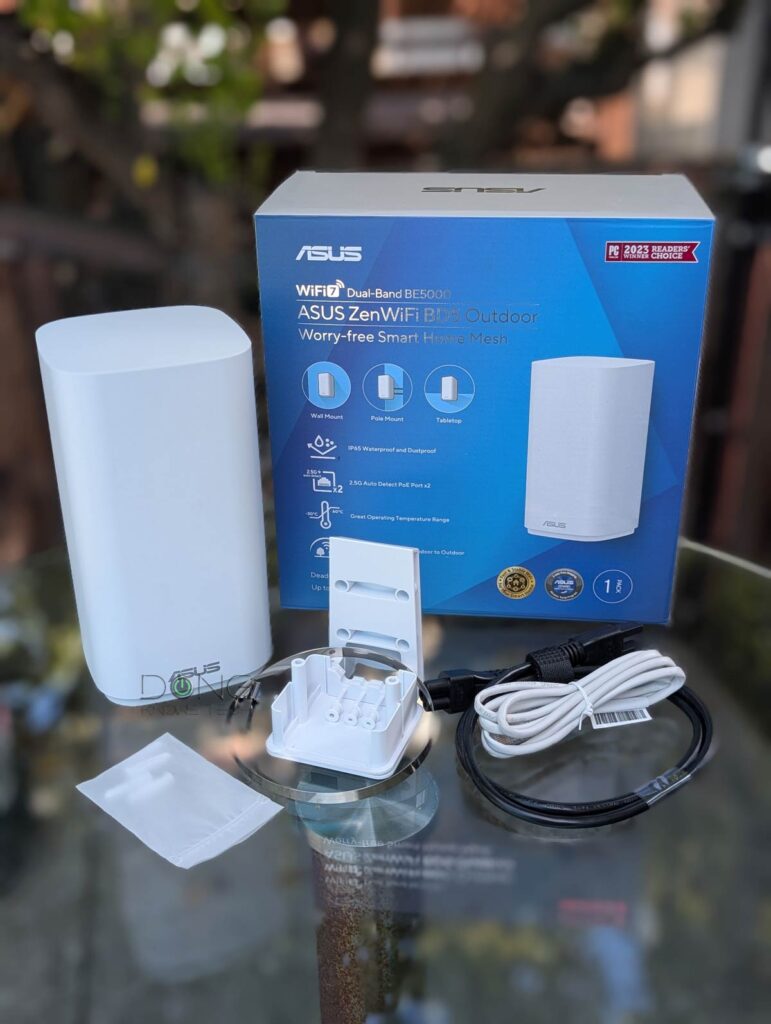
ASUS ZenWiFi BD5 Outdoor: A Dual-band AiMesh router that’s also an excellent PoE access point
Out of the box, the ZenWiFi BD5 Outdoor looks quite different from the ZenWiFi BD5. It’s a tall, slender box designed for outdoor use with IP65 ruggedness—it’s dust-tight and can handle water splashes or rain. It’s also heavier because it has the power adapter on the inside. Most significantly, though, it has two 2.5Gbps PoE auto-sensing ports that are PoE-ready. You can use a network cable to power it.
Other than that, on the inside, the ZenWiFi BD5 Outdoor shares the same hardware specs as the ZenWiFi BD5. It’s a dual-band mid-tier Wi-Fi 7 broadcaster that supports up to 240MHz channel width on the 5GHz band to offer up to 5000Mbps of combined bandwidth.


The table below shows the hardware specs of the two.
Hardware specifications: ASUS ZenWiFi BD5 Outdoor vs. ZenWiFi BD5
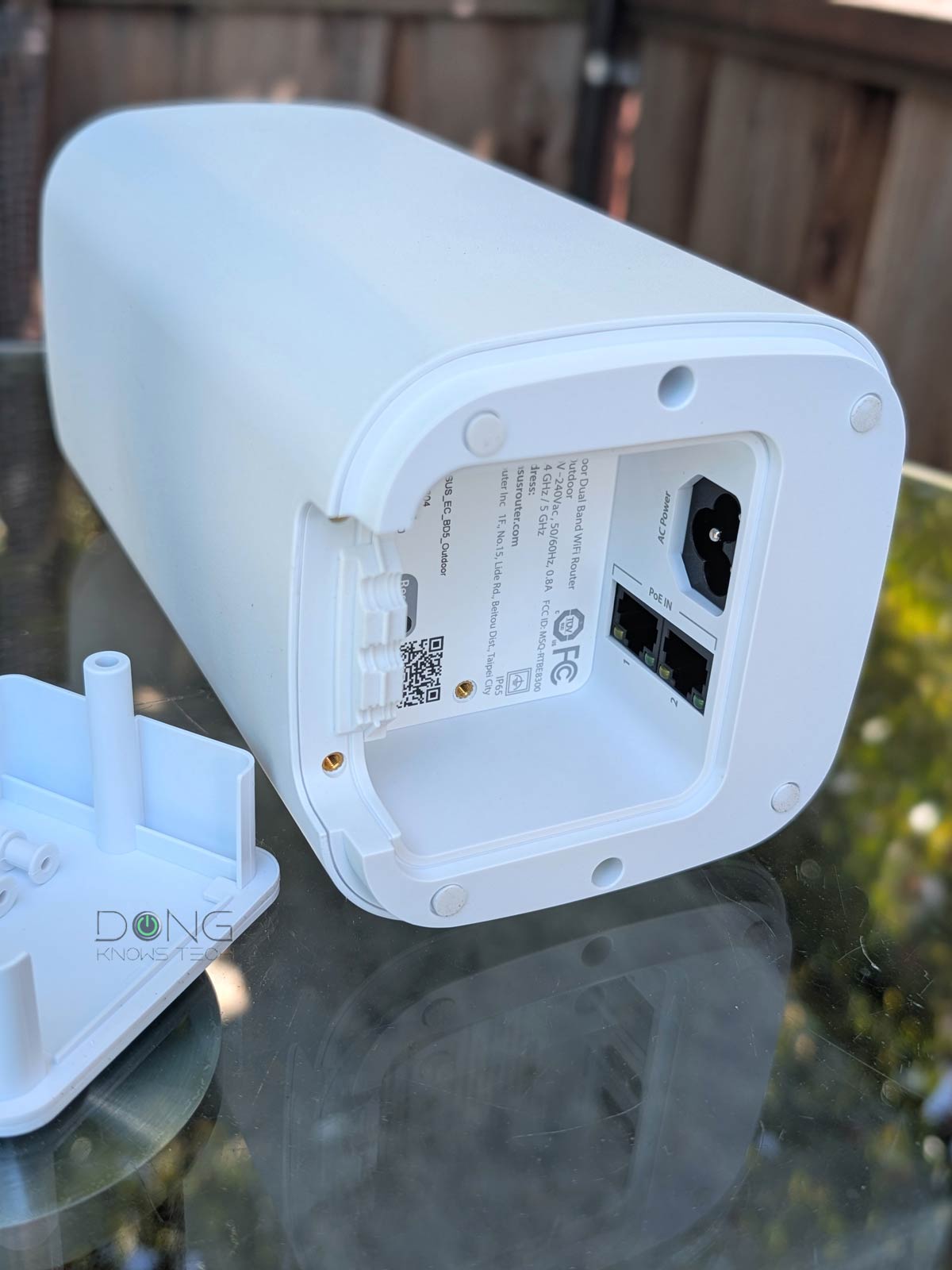 | 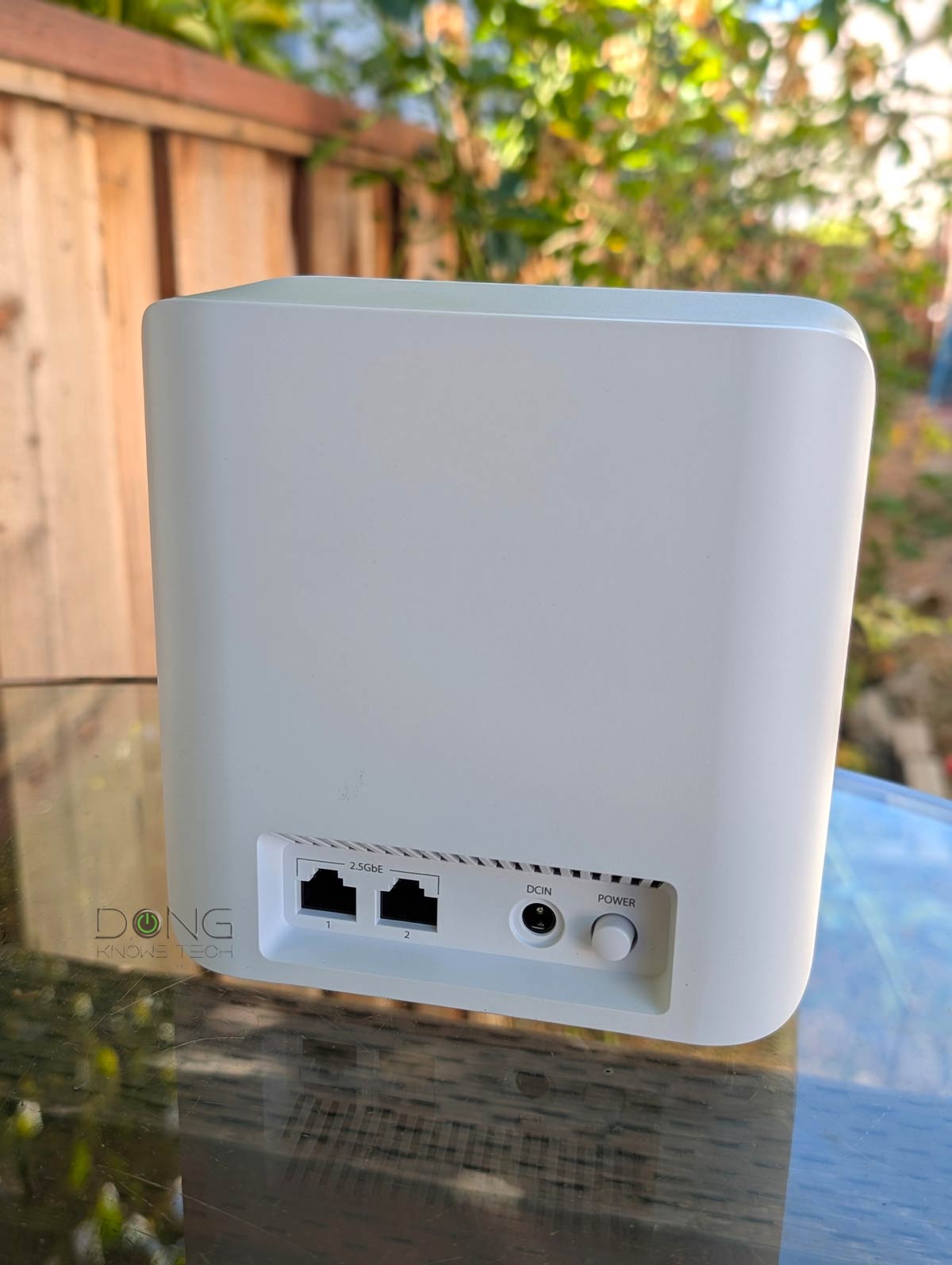 | |
|---|---|---|
| Name | ASUS ZenWiFi BD5 Outdoor Dual-band Wi-Fi 7 mesh router | ASUS ZenWiFi BD5 Dual-band Wi-Fi 7 mesh router |
| Model | ZenWiFi BD5 Outdoor | ZenWiFi BD5 |
| Processing Power (router unit) | Quad-core 1.5 GHz CPU, 128 MB flash, 512 GB RAM | |
| AiMesh Support | Yes (as a primary node or a satellite) | |
| Possible Dedicated Backhaul Band (default) | None | |
| Wired Backhaul | Yes | |
| Dimensions | 4.17 x 4.17 x 7.87 in (106 x 106 x 200 mm) | 5.51 x 2.75 x 5.51 in (140 x 70 x 140 mm) |
| Weight | 2.29 lbs (1040 g) | 1.15 lbs (520 g) |
| Outdoor Ruggedness | IP65 | None |
| Wi-Fi Bandwidth | Dual-band BE5000 | |
| 2.4GHz Band (channel width) | 2×2 BE: Up to 688Mbps (20/40MHz) | |
| 5GHz Band (channel width) | 2×2 BE: Up to 4324Mbps (20/40/80/160/240MHz) | |
| Automated Frequency Coordination (AFC) | N/A (only applicable to the 6GHz band) | |
| Multi-Link Operation (MLO) | Yes | |
| Backward Compatibility | 802.11ax/ac/n/g/a/b | |
| Virtual SSIDs (SDN Networks) | Guest, IoT, MLO, Kids, VPN | |
| Mobile App | Asus Router | |
| Web User Interface | Full (with everything) | |
| Operation Modes | Router (AiMesh Router) AiMesh Satellite Access Point | Router (AiMesh Router) AiMesh Satellite Access Point Repeater |
| USB Port | None | |
| Gigabit Port | None | |
| Multi-Gig Port | 2 x 2.5Gbps PoE-in auto-sensing (PoE) | 2x 2.5Gbps auto-sensing |
| Dual-WAN and Link Aggregation | No | |
| Universal Restoration | No | |
| Firmware Version (at review) | 3.0.0.6.102_57127 | 3.0.0.6.102_58118 |
| U.S. Release Date | January, 2025 | |
| Power Specs | AC Input: 100-240V (built-in adapter), 802.3af PoE | Separate power adapter AC Input: 100-240V Output: 12V 1.5A |
| Real-World Power Consumption (per 24 hours) | Not measured (tested via PoE) | ≈155 Wh (router) ≈ 125 Wh (satellite) |
| U.S. Launch Price (Compare street prices!) | $179.99 (single unit) | $349.99 (3-pack) $249.99 (2-pack) $139.99 (single router) $179.99 (outdoor router) |


A versatile PoE-enabled dual-band Wi-Fi 7 broadcaster
As shown on the table above, like all ASUS AiMesh-enabled routers, the ZenWiFi BD5 Outdoor can work as:
- A standalone router (or the primary node of an AiMesh system). This is its default role. Or:
- An AiMesh satellite node. This is the recommended case in which you can add it to any existing AiMesh router or get a couple of hardware units to build a new system. Or:
- A standard access point. This case is applicable to a network hosted by a third-party router. Thanks to the PoE ports, the ZenWiFi BD5 Outdoor is comparable to business-class standard access points.
The ZenWiFi family generally doesn’t have the Repeater mode, unlike ASUS standalone routers, such as those in the RT series.


The ASUS ZenWiFi BD5 Outdoor works as the router out of the box. As such, it’s the same as the ASUS ZenWiFi BD5 in features and even performance.
Thanks to the outdoor design, though, and, again, the PoE support, it’s the first AiMesh router that can work excellently as a standard access point or a fitting AiMesh satellite node for those with a large outdoor area.
Let’s take a closer look at how it works as a Wi-Fi extending device.
ZenWiFi BD5 Outdoor: How to best use it to extend Wi-Fi coverage
To make it work as an AiMesh satellite, you can add it to any other AiMesh-enabled ASUS router, including another ZenWiFi BE5 Outdoor unit, via the standard setup process. A couple of things to keep in mind:
- It’s best to use it via wired backhauling, considering its PoE support—you’ll need a PoE injector or a PoE switch. In this case, you can use it with almost any AiMesh router per the combo rules.
- If you want to use it via wireless backhauling—a power outlet is required—and want to use MLO for that, you need to have a ZenWiFi BD5 or another ZenWiFi BD5 Outdoor unit as the primary router. In this case, mixing hardware means you’ll lose the MLO backhaul support.
Backhaul vs. fronthaul
When you use multiple Wi-Fi access points—in a mesh Wi-Fi system or a combo of a Wi-Fi router and an extender—there are two types of connections: fronthaul and backhaul.
Fronthaul is the Wi-Fi signals broadcast outward for clients or the local area network (LAN) ports for wired devices. It’s what we generally expect from a Wi-Fi broadcaster.
Backhaul (a.k.a. backbone), on the other hand, is the link between a Wi-Fi satellite unit and the network’s primary router, or between satellite units.
This link works behind the scenes to keep the hardware units together as a system. It also determines the ceiling bandwidth (and speed) of all devices connected to the particular Wi-Fi satellite unit.
At the satellite/extender unit, the connection used for the backhaul—a Wi-Fi link (wireless) or a network port (wired)—is often called the uplink. In a wireless uplink, keep the following in mind:
- Hardware of Wi-Fi 6e, Wi-Fi 6, or Wi-Fi 5 standards uses one of its bands (2.4GHz, 5GHz, or 6GHz) for the uplink. In this case:
- When a Wi-Fi band handles backhaul and fronthaul simultaneously, only half its bandwidth is available to either end.
- When a Wi-Fi band functions solely for backhauling, often available traditional Tri-band hardware, it’s called the dedicated backhaul.
- Most Wi-Fi 7 satellite units can use multiple bands for the backhaul link thanks to the MLO feature.
For the best performance and reliability, network cables are recommended for backhauling—wired backhauling, which is an advantage of mesh Wi-Fi hardware with network ports. In this case, a Wi-Fi satellite unit can use its entire Wi-Fi bandwidth for the fronthaul.
The ZenWiFi BD5 Outdoor, like all ASUS routers, has no hardware button to switch between its operation modes. As a result, to use it as an access point, you’ll first need to set it up as a standard router, then switch its Operation Mode to Access Point via its web user interface.
I tried that in a network hosted by a Ubiquiti UCG-Fiber, and it worked out as intended, though the process proved to be a bit more time-consuming than using a UniFi access point. Still, the Outdoor is indeed an excellent access point for anyone needing to extend their Wi-Fi coverage outdoors—it costs significantly less in most cases, among other things.
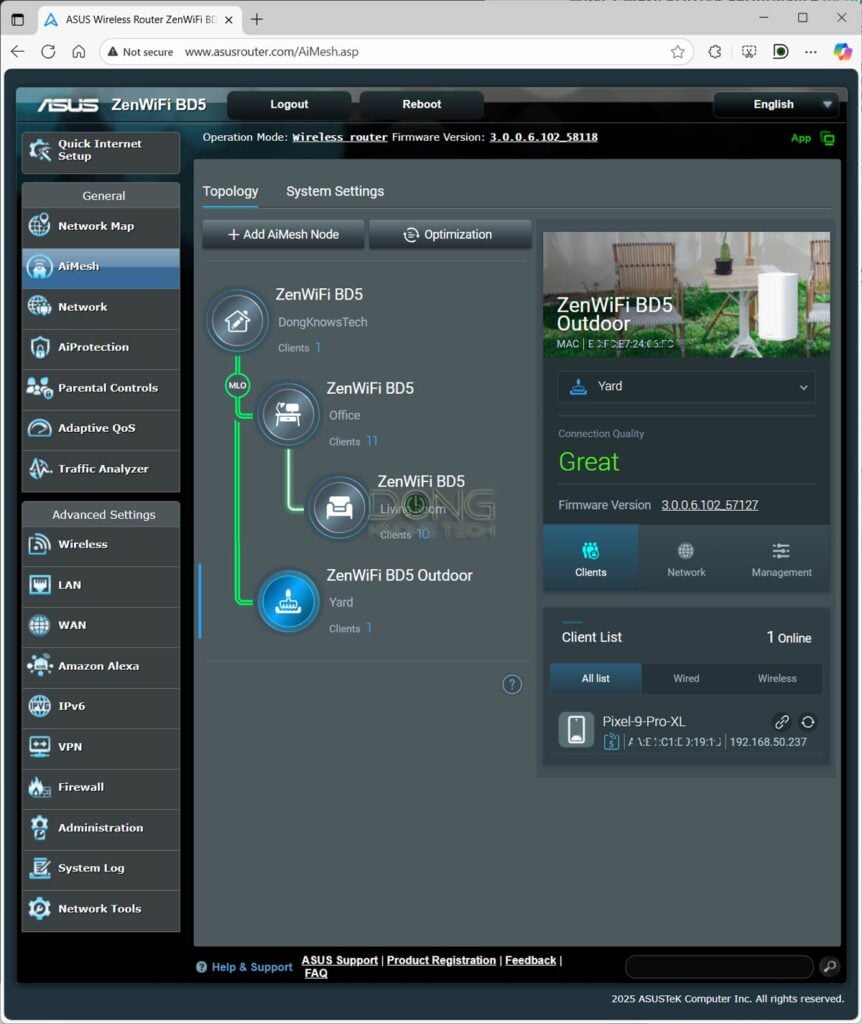
With the above available roles, it’s worth elaborating a bit on the ZenWiFi BD5 Outdoor’s two auto-sensing PoE ports. Specifically:
- You can use either (or both) as the PoE-in to power the router itself. If both are used as PoE-in, one works as redundancy.
- In the router mode (default), whichever port connects to the Internet source will work as the WAN port, and the other will work as a LAN port.
- In the access point or AiMesh satellite node mode, whichever port connects to the existing router will work as the uplink, and the other will work as a LAN port.
I used it extensively via PoE, and it proved to be quite a pleasant surprise.
ASUS ZenWiFi BD5 Outdoor: Excellent performance
As mentioned, I tested the ASUS ZenWiFi BD5 Outdoor together with a 3-pack of ASUS ZenWiFi BD5, and its performance was similar in terms of throughput speeds. Its range was slightly better when used indoors, though not by much. And indoor is not where it’s designed to shine.


Outside, its range could easily blanket my 4000 ft2 (372 m2) back yard when placed at one side of it, which is over 50 feet (15 meters) from the other side. In fact, its signals reached well over to our neighbors’ properties, and I couldn’t just jump over the fence willy-nilly for testing—I did think about that, though.
The ZenWiFi BD5 Outdoor passed my 3-day stress test without disconnection—there was no rain during this period, but I sprayed it with a garden hose many times when watering the plants. It did get a little warm to the touch during the day, likely due to having an internal power adapter, though not to the point of concern. It was silent, however, and seemed not to have an internal fan.
ASUS ZenWiFi BD5 Outdoor's Rating
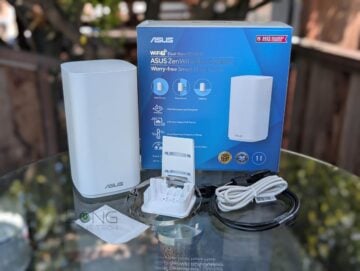
Pros
Rugged IP65 design with excellent real-world Wi-Fi rates and coverage
Versatile thanks to the dual 2.5Gbps PoE auto-sensing ports; lots of customization and free-for-life high-end features (VPN, Parental Controls, Online Protection, Smart Home Master, etc.).
Can work as a standalone router, a standard PoE access point, or an AiMesh member
Pole mounting accessories included; comparatively affordable
Cons
No wall-mount accessories included
Can't take setting backup files of other ASUS routers; no PoE injector included
The takeaway
The ASUS ZenWiFi BD5 Outdoor is an excellent mesh router that can work in multiple roles to fit in any situation. That plus the dual 2.5Gbps PoE ports means it’s a steal at the sub-$200 retail cost.
To put things in perspective, the Amazon eero Outdoor 7 access point costs more than double, has lower Wi-Fi specs, and can’t hold a candle to it in terms of features and settings alone.
Looking to blanket your large property with Gig+ class bandwidth? Consider one or a couple of ASUS ZenWiFi BD5 units today. Make sure you run network cables first, though.



Great review Dong!
1. Would this help if you already had an Asus Mesh network inside the home are are trying to get Internet access outside to a barn about 30m away?
When Gigabit+ broadband became available (we currently opted for 1Gbps), we installed internal wired backhaul within our home and use three Asus RT-AX82U Wifi 6 units (one being the router) for Wifi in the home having read your Reviews. This actually does seem to extend outside too to an extent. Very pleased with the Asus set up!
Whilst we have wired ethernet sockets in our home, there isn’t any wired connectivity in the outbuilding. It’s about 30m away (with a garage in between) from the nearest side of the house and the main Router. I’m trying to figure out if it’s possible to set up a camera in the barn whose apparatus/unit needs an ethernet connection to a switch/router or Wifi access.
I looked into ‘point to point’ Wifi access points (that claim to be able to send signals outdoors between two buildings for miles) sold in pairs on Amazon. And saw the Asus Zen BD4 and now just saw your review for the Asus Zen BD5 and Asus Zen Outdoor BD5.
2. Could you potentially utilise a pair of the Asus Zen BD5 units with one connected to our existing Asus Router and the other out in the barn 30m away? What we’re trying to do is see if we would be able to connect the camera’s little hub unit to the new satellite node by ethernet cable in the outbuilding. Getting the Internet over there wirelessly given it’s 30-35m away.
3. I was a little hesitant to add another Wifi system in case it interfered with our pre-existing Wifi and setup within our home (Asus RT-AX82U). Given one of the new “pair” would have to be set up inside the perimeter of the house.
Any advice would be appreciated!
Many thanks
1. Yes, you can run a network cable the barn (or near it) and place this one there.
2. I can’t answer the specifc in terms of distance, but this is an outdoor AP so you can use it outside. It’s also a PoE device so it’s best to use it with a network cable. Generally, outdoor is good for Wi-Fi range. This post will explain the Wi-Fi range in general.
3. You won’t add another system, you just extend the existing one.
1. We’ve run/installed network cables within in our house for our wireless access points which are all the Asus RT-AX82U. We cannot run a network cable from the house outside to the barn.
2. Yes I had a look at that article earlier. Would the Asus BD4 or BD5 be able to pick up the pre-existing Wifi signal from the existing Asus RT-AX82U set up then without causing interference with the main house? If you position one of the new Asus BD5 pair in an intermediary outbuilding and the other in the barn?
3. Is that better then than adding a new separate Wifi network with a new access point plugged in to the main Router at the house with a receiving access node in the barn?
I’m just trying to get a wired switch of some sort there. Unfortunately as I said earlier, we cannot extend our wired network to the barn.
Many thanks
1. You don’t need to run cable to the ban, but near it, or half way there, or just outside your home—the point is to get an outdoor unit as close to the to the barn as possible and out in the open. Now place the 2nd unit, at the ban, also outside ini the line of sight with the first unit and the two can connect wirelessly.
2. They don’t pick up the exising signal since the first unit is supposed to connecto the RT-AX82U via a network cable.
3. See #1.
Give this series on AiMesh a good read, Samantha—the link is for the first in the series, then follow #2 and #3 as shown in the related box at the beginning. It’ll answer all the questions. Nobody can give you specific answers from a far and you’re already at your place.
Thank you!
👍
Hi, I was wondering if when the BD5 Outdoor is connected to the AC power plug and running as an Ai Mesh node wirelessly would it add POE to the Ethernet ports. I have an Ethernet Security camera with POE I would like to plug in.
Thanks for the review of the BD5 Outdoor
No, Chris. That’s not how PoE works. You need a PoE-out port for that.
Great review!
I can’t seem to find the specs for the transmit power of the ASUS ZenWiFi BD5 Outdoor.
Do you have any detals?
Thanks!
There’s no information on that, John, which is the case of home-grade hardware as there’s no need to worry about that in general. But if you must know, then pick a business or enterprise-class access point, like the UniFi U7 Pro Outdoor.
Thanks, Dong
Great review! I have one of these and it works very nicely.
One (small) thing you mention: “As a result, to use it as an access point, you’ll first need to set it up as a standard router, then switch its Operation Mode to Access Point via its web user interface.” My own experience (with the ZenWifi products at least) is that you can set them up as an AP from the very beginning by choosing the ‘Advanced Options’ button on the welcome screen, there’s no need to set them up as a standard router first. Last time I did this, I connected via ethernet cable to my laptop to do the setting up. don’t know whether the experience is the same if configuring via the app.
Yes, that’s actually what I meant, Peter. When you first plug it in to set it up, it literally functions as a router by default. The point here is that you can’t use it up-front as an AP via a hardware button. Thanks for the input, though! 🙂
I installed this in a backyard in an indoor but unheated structure. I added it to an existing AIMesh network comprised of two ZenWiFi Pro XT12 units so I assume the backhaul is wireless. The goal was to improve the connection strength to a generator. It worked — the generator’s strength indicator more than doubled to about 75%. It’s a solid product that’s easy to install if you don’t care about tweaking the settings.
And you can tweak the settings quite a bit, too. Thanks for the input!
Not real savvy about all this but I need to extend my backyard. I have a RT-AXE7800 main router. No network cable to the satellite so it would be a wireless connection. Only need the 2.4ghz or possibly 5ghz around the back perimeter, 200 ft deep or so. It’s a 1.75 acre plot. The install could be covered in the back patio. Currently I get spotty coverage to the main router from my iPhone. Is this a good fit?
Nope, Philip. It’ll work to an extent, but good, no. You need a ZenWifi BD5 in the RT-AXE7800’s place. Or run a network cable.